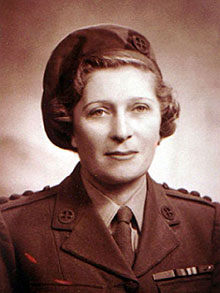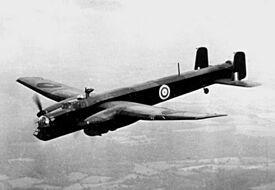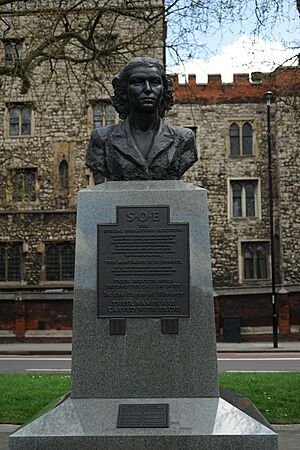Lise de Baissac facts for kids
Quick facts for kids
Lise de Baissac
|
|
|---|---|

In FANY uniform after joining SOE.
|
|
| Nickname(s) | Odile, Irène, Marguerite, Adèle (SOE codenames) |
| Born | 11 May 1905 Curepipe, Mauritius |
| Died | 29 March 2004 (aged 98) Marseille, France |
| Allegiance | United Kingdom, France |
| Service/ |
Special Operations Executive, First Aid Nursing Yeomanry |
| Years of service | 1942–1944 (SOE/FANY) |
| Unit | Scientist (SOE) |
| Battles/wars | Second World War |
| Relations | Claude de Baissac Mary Katherine Herbert |
Lise Marie Jeanette de Baissac (born May 11, 1905 – died March 29, 2004) was a brave agent during World War II. She worked for a secret British organization called the Special Operations Executive (SOE). Her job was to help the French Resistance in France, which was occupied by Nazi Germany.
The SOE's main goal was to spy, cause trouble for the enemy, and gather information. They worked with local resistance groups. They also sent weapons and supplies by parachute from England. Lise de Baissac was one of the first women SOE agents to parachute into France in September 1942.
She completed two important missions in France. She often worked with her brother, Claude de Baissac, who led a SOE network. They were very helpful just before and after D-Day. This was when the Allied forces invaded France. The de Baissacs armed and organized French Resistance fighters. These fighters then slowed down the German army and helped the Allies. Lise de Baissac often met German soldiers but was never caught. She received several awards for her bravery after the war.
Contents
Early Life and Joining the SOE
Lise de Baissac was born in British Mauritius. She was the only daughter in a family of three children. Her family owned a lot of land there. In 1919, her family moved to Paris, France. When she was 17, she met Gustave Villameur, an artist. Her mother did not approve of their relationship. Lise then went to Italy for a while.
After returning to Paris, Lise worked in an office. This was unusual for young women from wealthy families at that time. In 1940, German forces occupied Paris. Her older brother, Jean, joined the British Army. Lise and her younger brother, Claude, tried to reach England. They traveled to the Dordogne region in southern France.
They got help from the American Consulate to travel to England. They crossed into Spain and then went to Lisbon, Portugal. They waited there for five months to get permission to travel to Gibraltar and then to the United Kingdom. They finally arrived in Scotland in 1941. Lise then went to London. She got a job at a newspaper called the Daily Sketch. Her brother Claude was recruited by the SOE. Many people from Mauritius were recruited by the SOE. This was because they spoke both English and French very well. Fourteen Mauritians served with the SOE during World War II.
Secret Missions for the SOE
As soon as the SOE started recruiting women, Lise de Baissac applied to join. She was interviewed and accepted for training in May 1942. She was described as a "mature woman of thirty-seven." She was small, with black hair and light eyes. She also had a very confident way about her. She was known for being "difficult but dedicated."
Female SOE agents usually worked as couriers or radio operators. They worked for male "organizers." But Lise de Baissac was seen as someone who could lead her own network. Her training took place in Beaulieu, Hampshire. She trained with other women, including Odette Sansom. In July 1942, she joined the First Aid Nursing Yeomanry. Her trainers said she was "calm and collected in any situation." They also said she was "very much ahead of her fellow students."
First Mission in France
On the night of September 25, 1942, Lise de Baissac ("Odile") and Andrée Borrel ("Denise") became the first female SOE agents to parachute into occupied France. Lise de Baissac was seen off from RAF Tempsford in a Whitley bomber. They landed near the village of Bois Renard. Resistance leader Pierre Culioli met them. Borrel went to Paris to work for another network. Lise de Baissac went to Poitiers.
Lise de Baissac's job was to be a courier and a link for her brother Claude's network in Bordeaux. She also connected with other networks in Paris and Tours. Her mission was to create a new secret network. This network would be a safe place for other agents. It would also help organize the delivery of weapons from the UK. Her own network was called "Artist." She used several code names, including "Odile," "Irene," "Marguerite," and "Adele."
Her cover story was that she was a poor widow from Paris. She called herself Madame Irene Brisse. She said she was seeking refuge from the stress and food shortages in the capital. She rented an apartment on a busy street in Poitiers. It was even near the Gestapo headquarters. She often exchanged greetings with the Gestapo chief.
Lise de Baissac preferred working alone in Poitiers. She made local contacts and recruited people to the resistance. She rarely saw her brother. She also turned down an offer from SOE to send her a radio operator.
She created a system in Poitiers similar to what another agent, Virginia Hall, had done in Lyon. For 11 months, she lived in Poitiers. She met and briefed 13 new SOE agents. She also arranged for agents and resistance leaders to travel secretly to England. She pretended to be an amateur archaeologist. This gave her an excuse to bicycle around the countryside. She was actually looking for places where parachutes could drop supplies. She also looked for landing areas for RAF planes.
She collected containers of weapons and supplies dropped from the air. She then took them to safe houses. She also built her own resistance network. She recruited several "helpers," including a teenage girl. The girl traveled with her to make her activities seem normal. Lise had to travel to Paris or Bordeaux to communicate with London. This was because she had no radio operator. Her brother Claude was organizing sabotage missions there. He was also gathering information on ship and submarine movements.
In June 1943, many members of a network in Paris were arrested. Her Artist network was also discovered by the Gestapo. This made her risk of capture much higher. On the night of August 16/17, 1943, Lise and Claude de Baissac were flown back to England.
Second Mission in France
Lise de Baissac's return to France was delayed. This was because she broke her leg during a parachute jump. She could not parachute, so she returned to France by plane. She landed in a farm field on the night of April 9/10, 1944. She went to work as a courier for the Pimiento network in Toulouse. Her new code name was Marguerite.
However, Lise de Baissac wanted to do more important work. But she was only given small tasks. Her elegant manner did not fit well with the trade unionists and socialists in the Pimiento network. By agreement, she left Pimiento. She then joined her brother Claude. He had returned to France in February 1944. He was leading the Scientist network again. This network was now working in southern Normandy. Unknown to Lise and the French Resistance, Normandy would be the landing site for the Allied invasion on D-Day.
Lise de Baissac was her brother's courier. She bicycled 100 kilometers (about 60 miles) or more every day. She delivered messages. She also tried to stop the armed resistance fighters from attacking the Germans too early. The Scientist network's job was to find large open areas. These areas would be used for airborne troops to land and hold. They also received air-drops of weapons and supplies for the resistance.
Lise de Baissac stayed in the village of Saint-Aubin-du-Désert. This was about 100 kilometers (60 miles) south of where British troops would land on D-Day. She still pretended to be a poor widow from Paris. She rented the second floor of a house. It had two rooms and a mattress on the floor for a bed. On June 5, 1944, she was in Paris recruiting fighters. That evening, she heard the BBC broadcast a secret code phrase. It meant the Allied invasion of France was about to happen.
Immediately, she bicycled back to her network. She traveled more than 300 kilometers (186 miles) in three days. She passed through large groups of German soldiers. She slept in ditches along the way.
When she arrived at her base near Normandy, Lise de Baissac gathered information about German positions. She then passed it to the Allies. She once said that "the Germans arrived and threw me out of my room." She went to get her clothes. She found that the Germans had opened the parachute she used as a sleeping bag. They were sitting on it. Luckily, they had no idea what it was. Another time, she shared a schoolhouse with German army officers. They worked in the front room. She worked in a smaller room at the back. Lise de Baissac's calm confidence helped her. She successfully stopped German soldiers from taking her bicycle several times. On one occasion, Lise de Baissac and a group of resistance fighters had a gunfight with a German patrol. She reported that they killed several Germans.
The two months after the Normandy invasion were very busy for the Scientist network. At night, they gathered containers full of weapons for the resistance fighters. They also slowed down German reinforcements. They did this by placing land mines or tire-busters on the roads. During the day, Lise de Baissac bicycled from place to place. She was with an inexperienced radio operator, Phyllis Latour. Lise helped her with communications. These communications were needed to arrange weapon drops. They also provided information to the Allied forces, who were now only a few miles away.
On July 25, the American army launched Operation Cobra. This forced the German army to quickly retreat from the Scientist network's area. On August 13, the de Baissacs met up with a leading unit of U.S. soldiers. They were wearing British military uniforms that they had not worn for a long time. They stood in front of the mayor's office in a town. They greeted the arriving American soldiers. A few days later, the de Baissacs were flown to England. Their mission was complete.
Finding Mary Herbert
In September 1944, the de Baissacs were back in France. France was now free from German occupation. They were part of a mission to find lost and captured SOE agents. They also looked for the French people who had worked with them. Claude was the father of a daughter, Claudine, born in December 1943, with Mary Katherine Herbert. But he and the SOE had lost contact with Mary. The de Baissacs tracked Mary Herbert from Bordeaux to Poitiers. They found her and her daughter in a house near Poitiers. The de Baissacs returned to England with them. Claude married Mary Herbert.
After the War
After World War II, Lise de Baissac worked for the BBC. In 1950, when she was 45, she married Gustave Villameur. He was her sweetheart from her teenage years. He had become a successful artist and interior decorator. They lived in Marseille and did not have any children. Her husband died in 1978. After that, she lived alone in a beautiful apartment in Marseille.
The Guardian newspaper described her as a "grande dame of the old school." This means she was a very important and respected woman. They said she was "fiercely independent, courageous, elegant and modest." She died on March 29, 2004, in Marseille. She was 98 years old.
In an interview, Lise de Baissac said that "the loneliness of a secret life" was her strongest feeling. She also said that "cold-blooded efficiency for long weary months" was needed more than heroism. In 2008, a French film called Female Agents (Les Femmes de l'ombre) was made about her life.
Recognition
Lise de Baissac received several honors for her brave service:
- France: Knight of the Légion d'honneur (the highest French award), Croix de Guerre 1939–1945 (a military honor) with palm.
- UK: Member of the Order of the British Empire (MBE), September 1945.
Her bravery was praised by many:
- One British officer said: "The role she played in aiding the maquis and the resistance in France will never be praised enough. She did much to help the resistance prepare before the American breakthrough in Mayenne."
- Her SOE file states: "She was the inspiring force for the groups in the Orne region. Through her actions, she caused heavy losses for the Germans. This was thanks to anti-tire devices scattered on roads near Saint-Aubin-du-Désert, Saint-Mars-du-Désert, and even as far as Laval, Le Mans and Rennes. She also took part in armed attacks on enemy groups."
| Order of the British Empire (Member) |
1939–1945 Star | France and Germany Star | War Medal 1939–1945 |
| Légion d'honneur (Chevalier) |
Croix de Guerre (France) | ||



